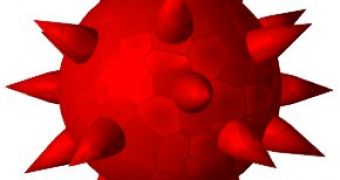University of Minnesota researchers carried out a study that concluded there might be a way of preventing HIV from infecting human cells.
HIV binds and destroys a certain human antiviral protein called APOBEC3F, and the U of M team figured out how, and said that a simple chemical change could turn APOBEC3F into a more effective antiviral agent.
The APOBECs are a family of antiviral proteins produced by the human body, that have a natural and one-of-a-kind ability to destroy HIV.
The problem is that HIV has evolved by using an accessory protein called Vif (virion infectivity factor) that degrades the APOBEC proteins and allows the virus to spread.
Lead author John Albin, a researcher in the laboratory of Reuben Harris, associate professor of biochemistry, molecular biology and biophysics in the College of Biological Sciences, and colleagues found out where Vif interacts with one antiviral protein, APOBEC3F, and proved that the connection can be interrupted by a simple chemical change on the surface of APOBEC3F.
They added that similar interactions also take place on the same surface of other members of this antiviral protein family.
Albin said that according to this, “the interaction between Vif and these antiviral APOBEC proteins could be blocked with a drug that would shield the Vif interaction region.
“Such an intervention has the potential to allow as many as seven natural antiviral drugs to spring into action and prevent HIV from spreading.”
The lab of Ruben Harris lab is trying to understand every level of this vital interaction between the APOBECs and HIV Vif.
Their discovery stresses the importance of a new approach in the fight against HIV/AIDS, that would try to stabilize and control the natural antiviral activity of some human proteins.
This way, in a not-so-far-away future, studies will have a more specific map of the physical interactions between Vif and APOBEC3 proteins, investigation of the potential for HIV to resist stabilizing changes in APOBEC3 proteins, and screens for drug-like compounds that help the cellular APOBECs destroy HIV.
Albin is a student in the Combined MD-PhD Training Program at the University of Minnesota Medical School, and through the Microbiology, Immunology & Cancer Biology PhD program, he is finishing his thesis, under Harris' guidance.
In 2003 and 2004, Harris contributed to the discovery of the APOBEC proteins' ability to counteract HIV infection, and in 2009 he won a grant from the Bill & Melinda Gates Foundation to explore ways of blocking HIV and APOBEC3 interaction.
His laboratory focuses on ways to harness mutations so that they destroy pathogens.
This new finding was published in the Journal of Biological Chemistry.

 14 DAY TRIAL //
14 DAY TRIAL //